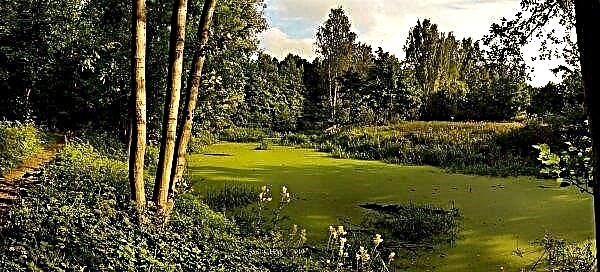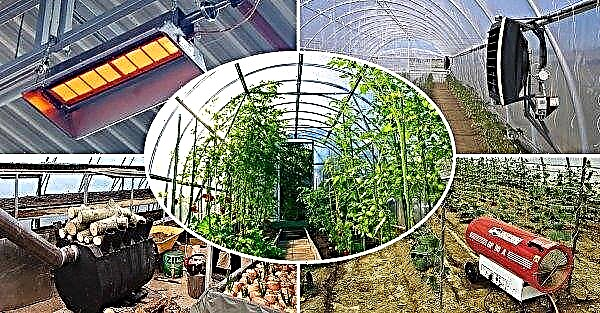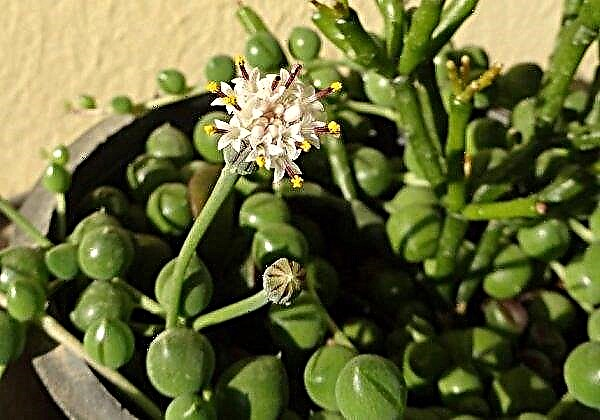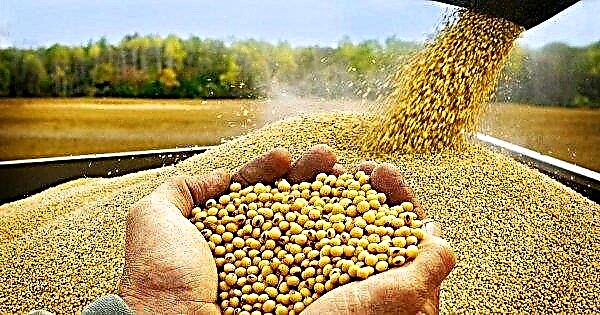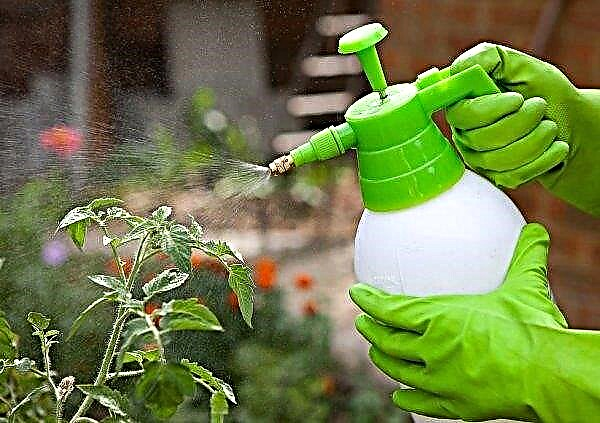A very important element of the infield is the walkways. When choosing material for paths in the garden, you need to consider not only external aesthetic characteristics and price, but also ease of use. The use of rubber flooring is a quick and modern way to create beautiful, neat, and most importantly - safe walkways and playgrounds for children's entertainment.
Types of rubber materials for garden paths
As raw materials for the manufacture of rubber coatings, used, old, wear-resistant car tires are used. The material is made by mixing crushed rubber particles, colored dyes and special glue.
Did you know? The crumb from rubber found wide application in construction of roads. Almost 2,000 tires are used per km of road, which is a great way to recycle worn tires.
There are three ways to make coatings:
- Hot pressing. With this production, the molding and polymerization of the product takes place simultaneously under the influence of pressure and high temperature in the oven. Through such processing, the material acquires a homogeneous structure, a certain shape and size.
- Cold pressing. The decomposed raw materials are pressed and then dried for a long time at + 60 ° C. With this production, the products may have a slight deviation from the set dimensions, and also differ in density.
- Vibration casting. With this method, the raw materials are also decomposed into shapes, and then compacted by vibration. Drying of such products lasts about two days.

On sale you can see three types of coatings:
Rolls
This type of flooring is a canvas up to 1.5 m wide and 5 to 15 mm thick.
The coating consists of two layers:
- lower - made from black raw material of a large fraction;
- top - made of small crumbs in any color scheme.
It is very convenient to work with rolled material. Installation of the canvas is carried out quite quickly with glue or stainless dowels.
This type of flooring, however, has its drawbacks:
- it is mounted only on a solid base;
- not suitable for curved platforms;
- requires the creation of the necessary conditions for draining water.
 With its shortcomings, the material is quite wear-resistant. This type of coating, mounted on a solid base and reinforced with reinforcement, is effectively used for flooring in parking lots. On sale you can also see a variety of antisplash entrance rugs made of this material.
With its shortcomings, the material is quite wear-resistant. This type of coating, mounted on a solid base and reinforced with reinforcement, is effectively used for flooring in parking lots. On sale you can also see a variety of antisplash entrance rugs made of this material.
Tile
The most used and profitable type of flooring. Products are produced both in a classic rectangular shape, and in the form of curly elements that differ in thickness and size. The maximum and minimum thickness of the segments, respectively, is 40 mm and 15 mm. Elements are mounted on a concrete screed with glue. Good results can also be achieved by applying mastic from bitumen.
The material has a lot of advantages:
- variety of shapes allows you to work with any lines, turns and roundness;
- all kinds of color combinations make the flooring unique;
- low price compared to coating in rolls.
Depending on the thickness, the tile is:
- single layer (no more than 10 mm thick);
- two-layer (material with a thickness of 10 to 40 mm);
- multilayer (from 40 mm).
Installation of a single-layer and two-layer type is carried out on a prepared solid surface. Multilayer elements are mounted both on a solid surface and on the ground. A variety of multilayer rubber tiles is pavers. Its thickness varies from 40 to 80 mm. The material is characterized by high strength and durability, and its main advantage is the ability to lay on any type of surface. Paving stones are laid on polyurethane adhesive or bitumen mastic. During installation, each element is attached to the adjacent one with special pins, such a connection of pavers helps to achieve the effect of a single canvas.
The material is characterized by high strength and durability, and its main advantage is the ability to lay on any type of surface. Paving stones are laid on polyurethane adhesive or bitumen mastic. During installation, each element is attached to the adjacent one with special pins, such a connection of pavers helps to achieve the effect of a single canvas.
Rubber crumb
The flooring consists of only two components: crushed to a fine fraction of rubber and polyurethane adhesive. The material is used not only on hard concrete, asphalt surfaces, but also on soft soil and sandy areas. Coating thickness depends on surface type. For hard areas the permissible thickness is 20 mm, and for soft substrates - from 25 mm.
- The main advantages of the flooring include:
- the possibility of mounting paths and sites of irregular geometric shapes;
- the finished coating is a high-strength monolithic structure;
- the most affordable price among other rubber materials.
To achieve high coating strength, two types of chips are used for laying: black and color. The black material has a larger fraction and is used for the lower layer. Colored, finer crumbs, stacked as the top layer.
Important! When laying pavers with a thickness of 80 mm, it is not necessary to use a mixture of sand and cement. It is enough to lay out a layer of sifted sand up to 70 mm thick, lay the elements, and then simply tamp them.
Despite the advantages listed above, working with rubber crumb requires special skills and the availability of additional equipment. Those who do not have experience with this material, it is better to give preference to other options for rubber flooring.
Video: laying crumb rubber
DIY styling
The process of laying the flooring is simple, but there are some subtleties that should be considered when working:
- Mandatory is the design of borders, they carry not only an aesthetic function, but also fix the canvas on the surface, in order to avoid displacement until completely dry.
- Covering the area with paving stones and tiles, you can do without a slope for rainwater drainage, but for the flooring in rolls, this point should be considered.
- When installing the flooring on a sand-cement mixture, it is recommended to use a tile with bushings, which has a groove-spike mounting system.
- The space between the plates and the curb must be filled with pieces of the main material until the elements are firmly joined.
- Laying tiles always starts in the middle of the track.
For reliable adhesion of the base and rubber material, you should pay attention to the following nuances:
- Air humidity. For work, you need to choose dry weather, the base under the flooring must be dry.
- Temperature mode. The optimum temperature is considered to be from + 5 ° C, but not higher than + 20 ° C.
- Dry weather for 2-3 days after installation. The specified time interval is necessary for the polymerization of the adhesive composition.
Did you know? The pigments used to color the material in the manufacture of rubber flooring are of natural origin and do not cause allergic reactions.
The set of tools and materials for laying the flooring of different types is practically the same:
- rubber plates, web or crumb;
- cord and pegs for marking tracks;
- special borders made of rubber;
- knife;
- polyurethane adhesive;
- container for glue;
- sand brush;
- roulette;
- measuring level;
- chalk for marking;
- spatula (special gear);
- roller;
- sponge;
- rubber mallet;
- bayonet and shovels;
- mechanical or manual ramming;
- protective gloves.

To the ground
On soft surfaces, such as soil or sand, rubber tiles with a thickness of 30 mm or paving stones can be laid.
The flooring is mounted in several stages:
- Cleans the area from weeds and roots.
- Remove the topsoil.
- Tamping the surface.
- A layer of gravel 8-10 cm thick is lined.
- A mixture of sand and cement is prepared in a ratio of 3: 1.
- On top of the gravel, the cement-sand composition is evenly distributed.
- Lay the tiles in accordance with the ornament, leaving a small gap between the fragments (from 5 to 7 mm).
- The distance between the tiles is covered with sand.
- Excess sand is brushed off or washed off with water.
On a hard surface
Before starting work, it is necessary to examine the surface, to identify the presence of cracks and deformed areas. All significant irregularities before installation must be eliminated. Slight flaws are allowed. Laying on a hard surface may vary depending on the type of material.
Tile mounting:
- Treat the area with a primer. It is recommended to use soil on concrete or a mixture of polyurethane adhesive and acetone. Wait for the base to dry.
- Using the cord and pegs, make markings.
- Apply adhesive to the tile using a spatula.
- Press the material to the base as much as possible and gently ram it with a rubber mallet.
- Remove excess glue that has gone beyond the base material.
- Set the curb.

Rubber crumb coating:
- Thoroughly clean the surface of dirt particles.
- Apply primer.
- Using a construction mixer, mix the rubber and adhesive base in the proportions specified by the manufacturer.
- Add color pigment of the desired shade.
- Treat the rolling roller with an emulsion that does not adhere the rubber mass to the tool.
- Level the composition with a roller and leave to dry for at least 24 hours.

Care Rules
Recycled rubber flooring is quite resistant to natural factors. Soiled cloth is washed with a small pressure of water. If persistent dirt or stains appear, then it will be easy to remove them with a sponge or brush dipped in soapy water. In the cold season, icing over the tiles can be split with an ice pick, and then removed with a brush with hard bristles. It is recommended to sweep away or remove snow with a light shovel made of plastic. In large areas, the use of snow removal equipment is allowed.
Important! Crumb rubber flooring, designed for heavy loads, is put into operation no earlier than a week after installation.
Pros and cons of rubber coating
Rubber coating materials have a host of advantages that can displace such competing concrete products.
- The positive qualities include:
- resistance to the negative effects of external factors;
- low degree of susceptibility to deformation during use;
- ease of installation work;
- simplicity in fitting the desired shape of the product;
- the possibility of dismantling the material without loss of quality, as well as the reuse of the flooring;
- resistance to the processes of decay and the formation of fungal plaque;
- safety and lack of emissions of harmful substances;
- ease in leaving;
- resistance to rot and fungus;
- the widest choice of color schemes, the ability to create an ornament, pattern.
- The main disadvantages are:
- flammability of the material;
- quick heat in the sun;
- high price.
 Rubber tracks are simply indispensable for landscaping a suburban area or cottage. The coating is soft, wear-resistant and, most importantly, safe for loved ones, especially for children. Installation of garden paths made of rubber does not require special preparation and special skills, it can be done with your own hands, using your own imagination and taking into account your wishes.
Rubber tracks are simply indispensable for landscaping a suburban area or cottage. The coating is soft, wear-resistant and, most importantly, safe for loved ones, especially for children. Installation of garden paths made of rubber does not require special preparation and special skills, it can be done with your own hands, using your own imagination and taking into account your wishes.

